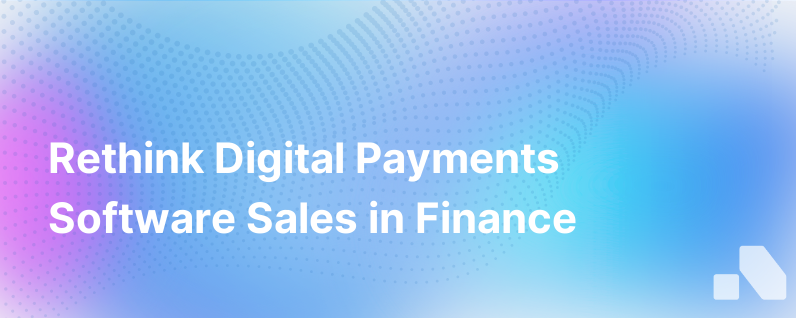
In the ever-evolving landscape of the financial world, institutions are facing a challenging paradox: while the demand for seamless digital payment solutions is at an all-time high, the traditional methods of selling this software are becoming increasingly ineffective. As digital transformation accelerates, financial institutions must adapt their sales strategies to stay relevant and foster strong customer relationships.
The Winds of Change
Outdated Techniques
The old sales approach—cold calling, product-focused pitches, and one-size-fits-all solutions—does not cut it anymore. Those tactics fail to address the nuanced needs of today’s businesses which are looking for bespoke solutions that mesh with their intricate digital ecosystems.
Personalization and Customization
Modern customers demand personalization and customization, wanting digital payment solutions tailored to specific business models, regulatory environments, and customer experiences. They seek partnerships that offer a consultative, problem-solving approach rather than mere transactions.
The Importance of Value Proposition
With a plethora of options available, institutions must now differentiate their offerings by articulating a clear, compelling value proposition. It's not just about the software anymore, but about the overarching experience, the ongoing support, and the ability to deliver measurable business outcomes.
Insight and Consultative Selling
Understanding Client Needs
A critical step in modernizing sales tactics involves a deep dive into understanding the specific challenges and opportunities within each potential client's business. This approach requires thorough industry research, engagement with key stakeholders, and an empathetic understanding of the end-users’ journey.
Solution Selling
In the current climate, successful salespeople are those who position themselves as trusted advisors rather than mere vendors. They engage in meaningful conversations, offer insightful analyses, and provide tailored recommendations that resonate with client needs.
Thought Leadership
Financial institutions should leverage thought leadership to showcase their expertise. By producing valuable content — such as case studies, white papers, and industry reports— they can address pain points, highlight trends, and engage potential clients in a more substantive dialogue about their business needs.
Harnessing Technology for Sales Enablement
Tools for Effective Sales
Leveraging CRM tools, AI, and machine learning can provide sales representatives with a wealth of information to personalize engagements. Predictive analytics can reveal cross-sell and up-sell opportunities, while AI can assist in identifying the right decision-makers within target organizations.
Digital Engagement Platforms
With in-person meetings less frequent, institutions must perfect digital engagement. Video calls, webinars, virtual demos, and interactive platforms are becoming indispensable for effective sales presentations and training sessions about complex payment solutions.
Continuous Feedback Loop
Technology also enables a feedback loop from customers post-sale. Institutions can track usage, gather customer feedback, and continuously refine their offering. This degree of responsiveness to customer needs is impossible with traditional sales methods.
The Role of Agility and Adaptation
Pivot Quickly
The ability to pivot sales strategies as market conditions or client needs change is crucial. Financial institutions must cultivate a culture of agility and encourage sales teams to experiment with innovative approaches, learn from failures, and adapt quickly.
Training and Development
Equally important is the ongoing training and development of sales teams. As digital payment solutions become more sophisticated, sales representatives must keep pace with evolving product knowledge, technology tools, competitive landscapes, and industry compliance.
Collaboration and Partnership Ecosystems
Beyond the Transaction
Modern selling is as much about collaboration as competition. Financial institutions should embrace partnerships with fintech companies, payment processors, and even competitors to provide a more comprehensive solution to clients.
Ecosystem Value-Add
Being part of a broader ecosystem allows institutions to offer value-add services that enhance their core payment solutions. It positions them as integral parts of their clients' operational success, rather than just software providers.
Embracing Storytelling and Brand Experience
Narratives that Resonate
Today’s B2B clients respond well to storytelling that illustrates a clear narrative around problem-solving and enabling success. Financial institutions must craft stories that resonate with their target audience’s aspirations and pain points.
Focus on Experience
Brand experience has transcended the confines of B2C and is a potent tool in the B2B realm. Financial services firms must ensure that every touchpoint, from initial contact through to post-sale support, underscores a positive brand experience.
Conclusion
The sales landscape for digital payments software is undergoing a profound transformation. Financial institutions that cling to outdated methodologies will find themselves outpaced by those willing to embrace modern sales techniques. Sales success will belong to those institutions that offer more than a product—they must provide deep industry insights, collaborations, technological innovation, and customer-centric solutions tailored to each client's unique needs.
As financial institutions rise to meet this challenge, they will find that the process not only elevates their sales strategy but also their overall value proposition in an increasingly competitive and digital marketplace.